Rare Porcelain Display
(page 5)
R=∞
Home
Rare Porcelain Display: Page
1 Page 2 Page
3 Page
4 Page 6 Page
7
R. Thomas & Sons (1898-1908)
There are a number of very rare insulators in the display that were made by R. Thomas & Sons Co. and the Lima Insulator Co. The Thomas “Bat Ears”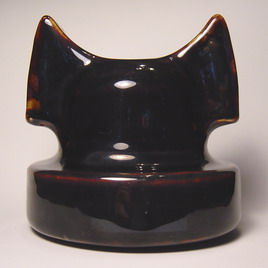 helmet, U-389, is a one-of-a-kind. The 1901 Etheridge patent is a unique design to hold large heavy cables. The insulators were mounted on a hollow pin and secured loosely with a spring clip that fit inside the pin and with the end extending in the special groove at the top of the pinhole. U-376 is a one-of-a-kind specimen
acquired from Lew Hohn in 1983. It has the incuse marking, LIMA, N.Y., on the dome and “No. 1” scratched on the bottom. The Thomas version was U-376A and U-376B. An unusual dry pressed Thomas insulator is U-923G. This one-of-a-kind insulator from Canada is unmarked and probably dates to circa 1895, about the time Thomas made U-923C for Fred Locke. In fact, U-923G has the extended center petticoat based on Fred Locke’s design in 1893-94, and probably was made for him.
helmet, U-389, is a one-of-a-kind. The 1901 Etheridge patent is a unique design to hold large heavy cables. The insulators were mounted on a hollow pin and secured loosely with a spring clip that fit inside the pin and with the end extending in the special groove at the top of the pinhole. U-376 is a one-of-a-kind specimen
acquired from Lew Hohn in 1983. It has the incuse marking, LIMA, N.Y., on the dome and “No. 1” scratched on the bottom. The Thomas version was U-376A and U-376B. An unusual dry pressed Thomas insulator is U-923G. This one-of-a-kind insulator from Canada is unmarked and probably dates to circa 1895, about the time Thomas made U-923C for Fred Locke. In fact, U-923G has the extended center petticoat based on Fred Locke’s design in 1893-94, and probably was made for him.
Thomas U-389 "Bat Ears"
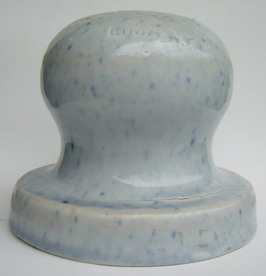

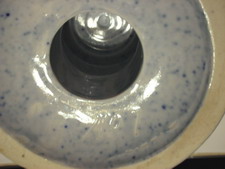
U-376 LIMA, N.Y. with "No. 1" scratched in the
bottom. It was probably Lima's No. 1 Etheridge style
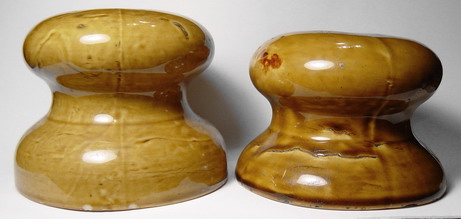
Thomas Etheridge patent insulators: U-376A and U-376B
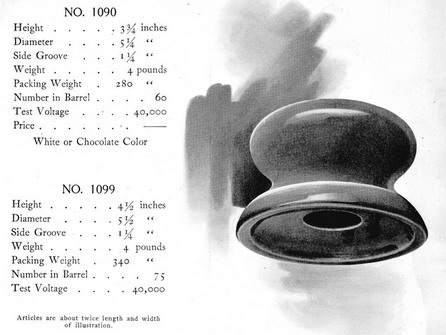
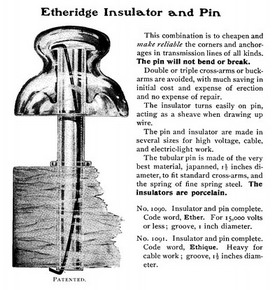
Thomas 1904 catalog showing U-376A (No. 1099) and U-376B
(No. 1090). The 1902 C. S. Knowles catalog (right) has a good illustration
that shows how the flat, spring metal clip secures the insulator on a hollow
metal pin that fits in a hole bored through the crossarm.
Thomas made U-945 based on Ralph Mershon’s June 7, 1898 patent for a long tubular petticoat to protect the pin from arcing and a plurality of short petticoats. Thomas made U-945 of three separate shells fused together with extra glaze, which was based on Boch’s March 8, 1898 “glaze-filling” patent. These rare insulators are incuse marked “Mershon Type” with the Mershon patent date. U-945 is a very desirable insulator. One specimen was so enjoyed by a collector, that his family placed it in his casket when he died of an unfortunate accident in the early 1980’s.
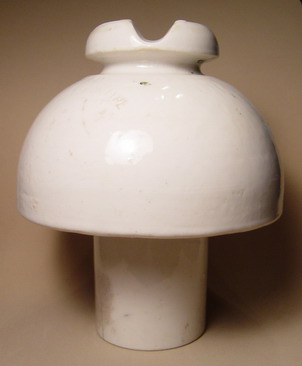
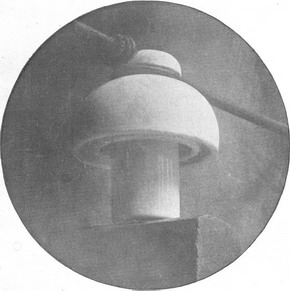
Specimen of Thomas' Mershon Patent U-945 (left) made using
the Boch "glaze-filling" process. At right is the photo that
appeared on the cover of Thomas' booklet titled "Glaze-Filled"
celebrating their final victory of the Boch patent over Fred Locke. The
booklet was published on March 8, 1902, the fourth anniversary of the Boch
patent. It reannounced to the world the famous Boch
"glaze-filled" insulator and included District Judge R. W. Archbald's
final decision dated Dec. 26, 1901, declaring that "I am not persuaded
by the re-argument that any mistake was made in sustaining the Boch patent in
its entirety...it is the product that is the important thing, rather than the
process by which it is brought about, to produce it."
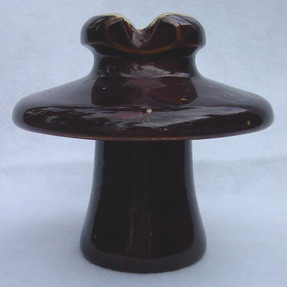
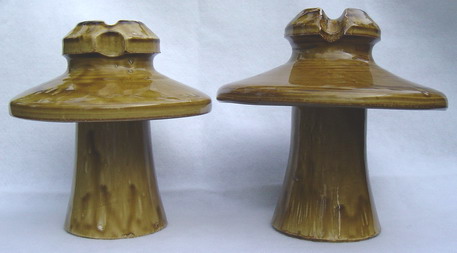
Other very rare Thomas insulators made by the Boch
"glaze-filling": U-956 (less than 5" tall), U-967, and U-967A
(9" tall). The light mottled caramel colored glazes indicate
production circa 1902.
Other insulators in the display made by Thomas using Boch’s “glaze-filling” patent are U-956 (circa 1910 two-part glazeweld with blue-jean seam, one known), U-967, and U-967A (both 2-part glazeweld styles from circa 1902-04; U-967A only one known). The top skirt has a unique drip edge around the top skirt. The beautiful caramel-colored glazes are characteristic of very early Thomas production after white-glazed insulators became out of favor in 1901. Insulators with white glazes were considered easy targets for hunters.
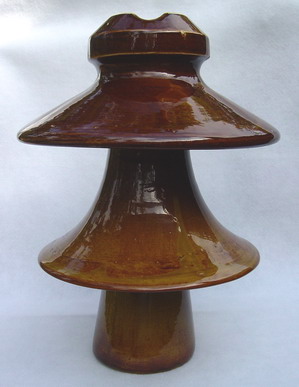
Thomas M-3250
Specimens of M-3250 are treasured by the few collectors lucky enough to own one. This particular specimen has a unique and beautiful glaze color of mottled orange with mustard highlights making it a very desirable lily-shell style. Only 12 specimens are known in the hobby. The first three had shells with mostly dark glazes. Four others are associated with switch gear and are not individual specimens. A group of six were found together which have a wide variety of glaze coloration with some very beautiful contrasting shells that include mostly blonde coloration. The specimen in the display is probably the one with the most beautiful overall colors. It still has the original wooden pin stuck in the pinhole which nearly fills the diameter of the bottom skirt. U-376A, U-376B, U-945, U-967, U-967A, and M-3250 were shown in the 1904 Thomas catalog.
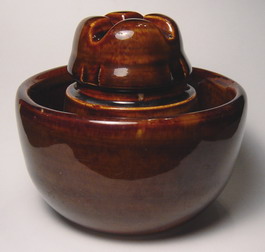
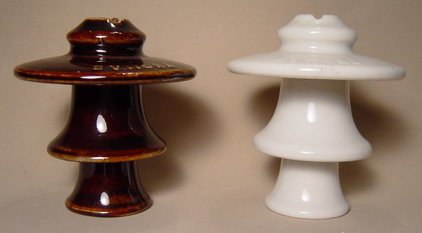
Left is a Thomas U-416. It was intended to be mounted
upside-down under a crossarm. According to Fred Koehler in the Dec. 1971
CJ, he removed three from the old San Francisco-Portland toll lead in the
Sacramento Canyon when this lead was removed on account of the Shasta Dam north
of Redding, CA. The linemen use to use them as ashtrays. U-416 was
used on the wires at the bottom of a canyon where there was an upward strain on
the wire on both sides of the insulator. The two Thomas salesman's samples
are only 2-1/2" tall. They were made of dry pressed porcelain and
have the embossed marking, THOMAS, around the upper edge of the top skirt.
They a miniatures of the famous M-3740.
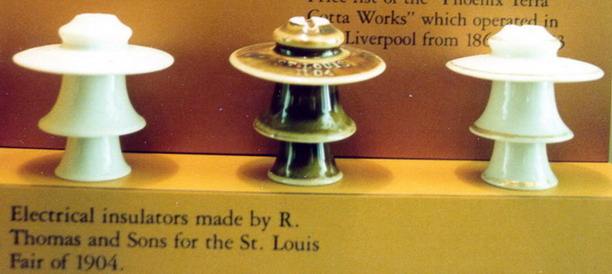
These Thomas salesman's samples are in the Museum of
Ceramics in East Liverpool, OH. Note the one on the right has the edges of
each skirt trimmed in gold. They were made as a giveaway for the 1904 St.
Louis World's Fair.
Lima Insulator Co. (1904-1908)
Fred Locke started the Lima Insulator Co. in 1904 about the time he “retired” from the Locke Victor factory. Lima, NY is a short distance from where Fred lived in Victor. He had to keep his ownership a secret putting all the property in his wife’s name. The factory was mostly destroyed by fire in September 1908, so few specimens exist and even fewer with the incuse marking, LIMA, N.Y.
Lima also had a few insulator styles that were made of 2 or 3 shells fused together with glaze by the common glazewelding process. The U-965 specimen in the display is the only one known. The small lily-shell design is made more attractive by the contrasting mottled medium tan top and light tan bottom
skirt.
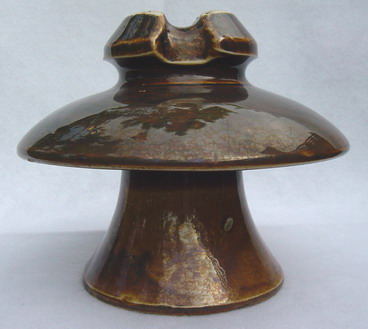
U-965 was made by Lima. It is a two-part
glazeweld.
Rare Porcelain Display: Page
1 Page 2 Page
3 Page
4 Page 6 Page
7
R=∞
Home
 helmet, U-389, is a one-of-a-kind. The 1901 Etheridge patent is a unique design to hold large heavy cables. The insulators were mounted on a hollow pin and secured loosely with a spring clip that fit inside the pin and with the end extending in the special groove at the top of the pinhole. U-376 is a one-of-a-kind specimen
acquired from Lew Hohn in 1983. It has the incuse marking, LIMA, N.Y., on the dome and “No. 1” scratched on the bottom. The Thomas version was U-376A and U-376B. An unusual dry pressed Thomas insulator is U-923G. This one-of-a-kind insulator from Canada is unmarked and probably dates to circa 1895, about the time Thomas made U-923C for Fred Locke. In fact, U-923G has the extended center petticoat based on Fred Locke’s design in 1893-94, and probably was made for him.
helmet, U-389, is a one-of-a-kind. The 1901 Etheridge patent is a unique design to hold large heavy cables. The insulators were mounted on a hollow pin and secured loosely with a spring clip that fit inside the pin and with the end extending in the special groove at the top of the pinhole. U-376 is a one-of-a-kind specimen
acquired from Lew Hohn in 1983. It has the incuse marking, LIMA, N.Y., on the dome and “No. 1” scratched on the bottom. The Thomas version was U-376A and U-376B. An unusual dry pressed Thomas insulator is U-923G. This one-of-a-kind insulator from Canada is unmarked and probably dates to circa 1895, about the time Thomas made U-923C for Fred Locke. In fact, U-923G has the extended center petticoat based on Fred Locke’s design in 1893-94, and probably was made for him. 












